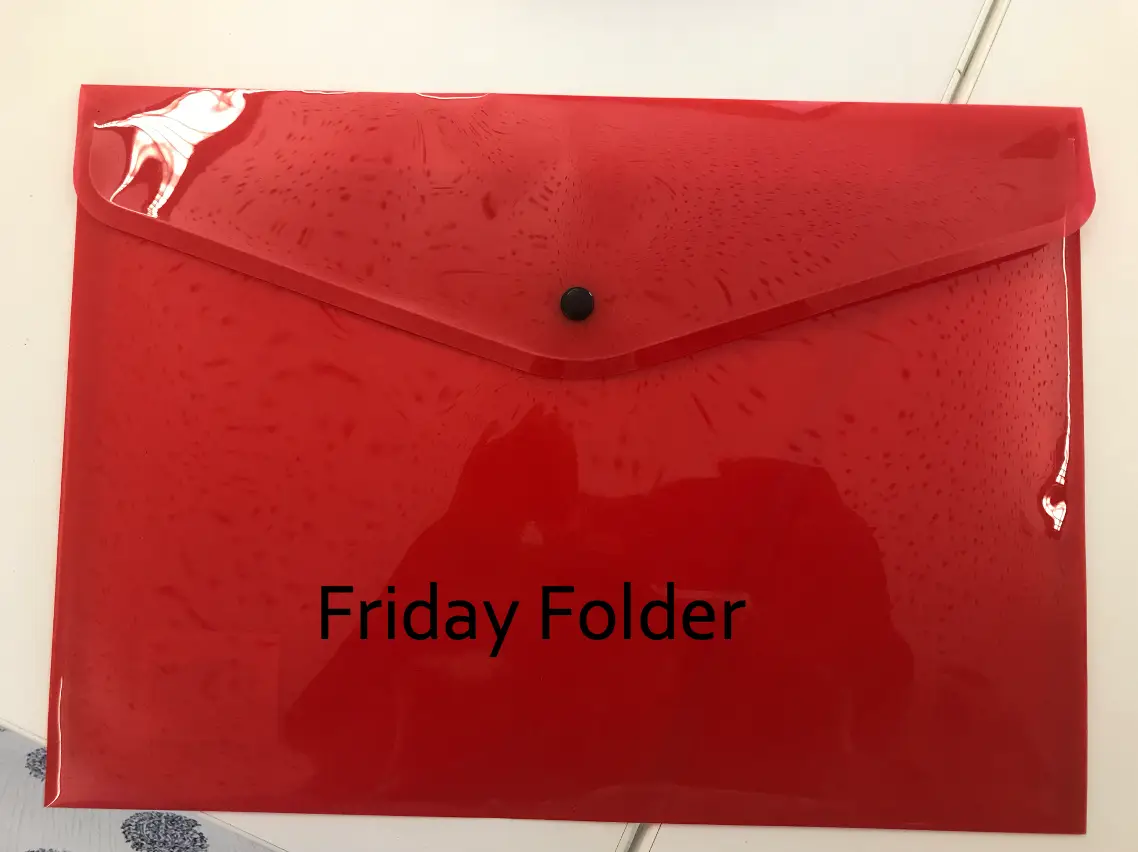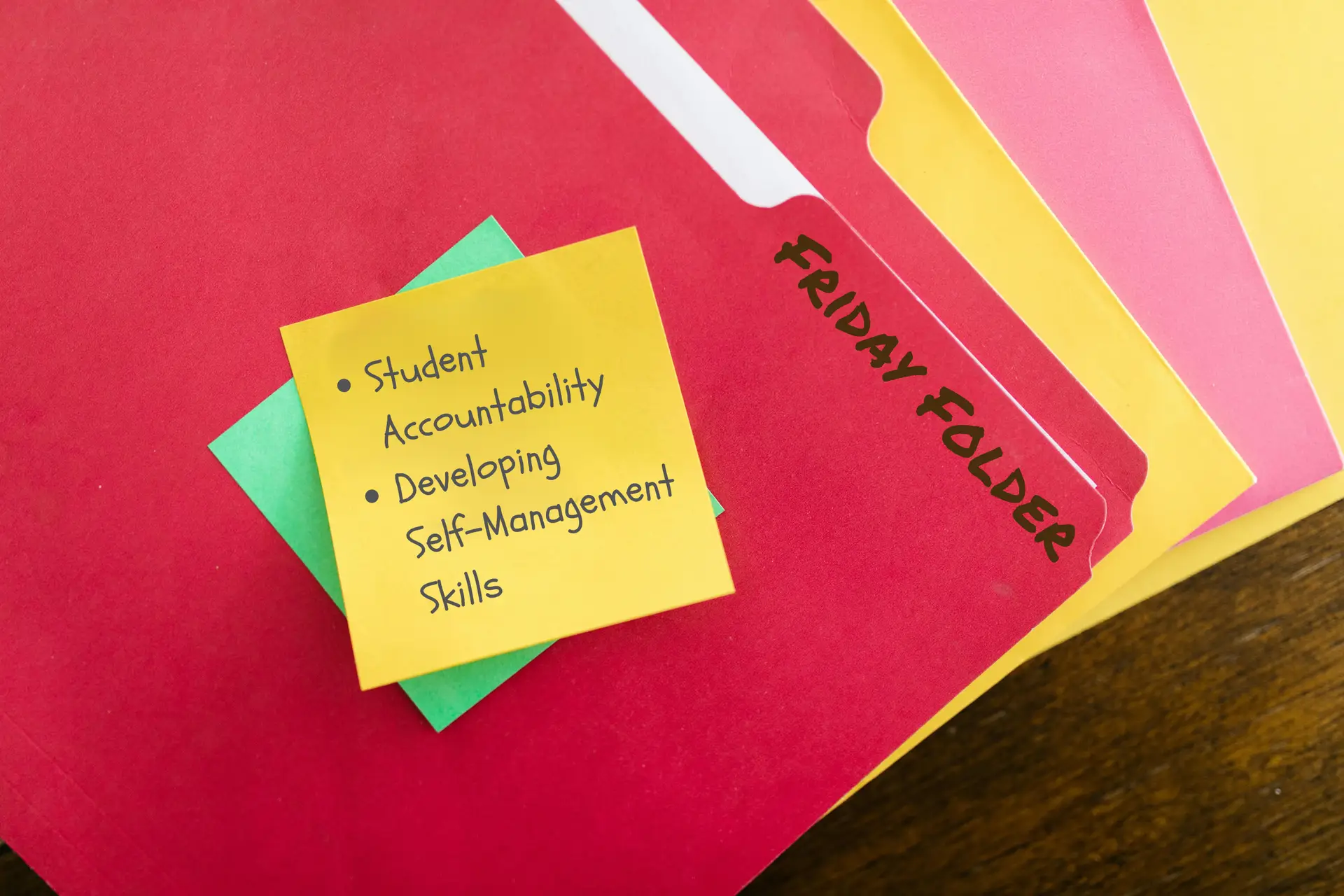One of my favorite systems for teaching accountability, responsibility, and time-management is also one of the simplest: Friday Folders.
I started using Friday Folders after noticing something that will probably sound familiar: some students just weren’t finishing their work. It wasn’t always about ability—it was about priorities. For some, there wasn’t much motivation to use work time effectively. They figured they could finish later or… not at all.
I didn’t want to punish students for missing a deadline, but I also didn’t want to ignore incomplete work. So I created a routine that gives students space to reflect and take ownership—without adding homework for the sake of homework.
Enter: Friday Folders.

What Are Friday Folders?
Friday Folders are a weekly routine where students take home incomplete classwork to finish over the weekend. These folders (I actually use plastic envelopes because they hold up better!) go home on Friday and are returned Monday morning.
Here’s what they’re not:
- They’re not for every piece of work a student didn’t get to.
- They’re not homework.
- They’re not a punishment.
Instead, Friday Folders are a tool for building accountability and helping students prioritize their class time—while communicating clearly with families about what still needs attention.
How It Works
I have a drawer in the classroom where all incomplete work goes during the week. Every Friday, before the end of the day, I pass out the plastic envelopes to each student and hand back their incomplete assignments—only the ones they reasonably should have finished.
That part is key: if most of the class didn’t complete something, it probably means I didn’t give enough time or the task needs to be broken down better. But if it’s an assignment that was manageable and most kids finished, then those who didn’t get it back to complete at home.
Then comes the checklist. Each student fills out a Friday Folder checklist, where they:
- Write down what work they’re taking home,
- Use it to check off completed tasks before returning it Monday,
- And keep parents in the loop.
Not only does this give students ownership of their unfinished work, but it also starts building those early time-management habits that are so important later in school—and life.
Tied to My Favorite Routine: 5 Minutes of Freedom
This system works especially well with another routine I love: Five Minutes of Freedom.
In case you’re new here, Five Minutes of Freedom is a short daily break I give students to do what they want—within boundaries. It happens between lessons and is completely student-directed. They can draw, read, chat quietly, or just take a breather.
It’s also a chance to prioritize.
Once we start using Friday Folders, many students naturally begin using their Five Minutes of Freedom to catch up on classwork. Without me saying a word, they start connecting the dots: “If I finish this now, I won’t have to take it home.”
That’s the kind of independent thinking I want to build. Responsibility doesn’t have to come from consequences—it can grow from small wins and real choices. Five Minutes of Freedom gives students time to self-manage and reflect. Friday Folders reinforce the value of making smart choices with that time.

If you want to read more about 5 Minutes of Freedom and other routines that I implement at the start of the school year, check out my post, First Week of School Routines, Procedures and Helpful Teacher Strategies.
Why Friday Folders Works
There are so many reasons I love Friday Folders:
- It encourages students to take ownership of their learning.
- It shifts motivation—students work harder during class so they can relax at home.
- It builds home-school communication without endless emails.
- It teaches reflection—students learn to look back at the week and evaluate what’s finished and what’s not.
But the best part? It feels empowering, not punitive. I never shame students who get folders full of work, and I always celebrate those who don’t have any. That quiet pride of turning in an empty folder on Monday is a big deal for many of them.
Over time, students start talking about how they had “less than last week,” or how they “got it done during Freedom Time.” They start tracking their own growth. They feel more capable. And that’s what we want, right?
But What About Differentiation?
Great question.
It’s important to know the difference between a student who didn’t finish because they were distracted and one who didn’t finish because the task was genuinely hard.
Friday Folders are not for penalizing students who need more time, support, or differentiation. If I’ve made accommodations or offered scaffolding for a student and they still need more time in class, then that’s what they get. Period.
The goal is not perfection. The goal is progress.
When students who’ve needed support finally don’t have anything to take home one week? We celebrate that big time. It’s a win for them, and for me.
Communicating with Families about Friday Folders
I always make it crystal clear to parents: Friday Folders are not homework. They’re a way to keep them in the loop and help students take responsibility for their learning.
When I introduce the system, I send home a letter explaining the purpose and the routine. I also include the checklist so parents can see what their child is working on.
This keeps the tone positive and proactive, rather than sounding like a behavior report.
Want to use Friday Folders in your classroom? I’ve created a free downloadable Friday Folder Checklist and Parent Letter Template to get you started. Grab yours below!
Friday Folders
Friday Folders freebie are designed to help you build a strong home-school partnership focused on developing your students’ self-management, accountability, and time-management skills.
Building Self-Management Skills with Friday Folders
At the end of the day, my goal is to help students become more independent and intentional with how they use their time. Friday Folders help with that in a way that feels fair and effective. They learn how to prioritize work, manage time, and take responsibility for finishing what they start.
And the best part? It’s a simple system that actually works—no bells and whistles required.
If you’re looking for a low-prep, high-impact routine that builds real-world learning habits, try implementing Friday Folders. You might be surprised at how quickly students rise to the occasion.
And if you’re looking for other routines that can make your life as a teacher a little bit easier, check out my blog post on First Week of School Routines, Procedures and helpful Teacher Strategies.

